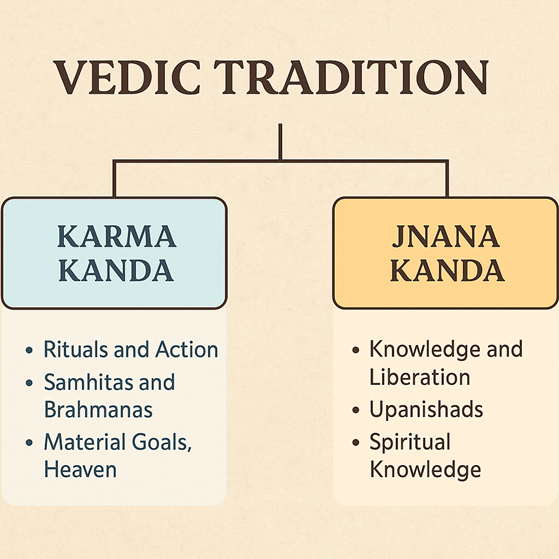KarmaKand
Karma Kāṇḍa (कर्मकाण्ड) is a significant portion of Vedic literature that deals with rituals, ceremonies, duties, and actions as prescribed in the earlier parts of the Vedas, primarily focused on maintaining worldly order and achieving material or heavenly rewards. It contrasts with Jñāna Kāṇḍa, which deals with knowledge and spiritual liberation.
Overview of Karma Kāṇḍa
- Literal Meaning:
- Karma = action or deed
- Kāṇḍa = section or division
- Hence, Karma Kāṇḍa = the section dealing with ritualistic actions.
- Focus:
- Performing prescribed Vedic rituals (Yajñas)
- Upholding Dharma (duty) through action
- Achieving material prosperity, social order, and Svarga (heaven)
- Scriptural Base:
- Samhitas and Brahmanas of the Vedas:
- Ṛgveda, Yajurveda, Sāmaveda, and Atharvaveda
- Rituals elaborated in texts like Aitareya Brahmana, Taittiriya Brahmana, etc.
- Pūrva Mīmāṃsā philosophy, especially by Jaimini, provides the theoretical foundation for Karma Kāṇḍa.
- Samhitas and Brahmanas of the Vedas:
Key Concepts in Karma Kāṇḍa
Yajña (Sacrificial Rituals)
- Central to Karma Kāṇḍa.
- Types include:
- Nitya Karma: Obligatory daily rituals (e.g., Agnihotra)
- Naimittika Karma: Performed on special occasions (e.g., Shraddha)
- Kāmya Karma: Desire-driven rituals (e.g., Putrakameshti for a child)
Dharma (Righteous Duty)
- Following one’s varna (caste) and ashrama (life stage) duties is emphasized.
- Actions done according to Vedic injunctions uphold cosmic order (ṛta).
Apūrva (Invisible Merit)
- Karma generates unseen merit (apūrva) that yields fruits later, often in another birth.
- Rewards include Svarga (heaven), wealth, offspring, etc.
Mantras and Brāhmaṇas
- Mantras (Vedic hymns) are recited during rituals.
- Brāhmaṇa texts explain the purpose, procedures, and meanings behind rituals.
Types of Rituals in Karma Kāṇḍa
| Type of Ritual | Purpose | Example |
| Shrauta | Major fire rituals using 3 fires | Agnihotra, Somayajña |
| Gṛhya | Domestic rites | Marriage, Naming (Namakarana) |
| Smārta | Based on Smriti texts | Shraddha (ancestor rites) |
| Ishti / Puroḍāsha | Offerings for specific desires | Putrakameshti (for progeny) |
Philosophical Underpinning
- Pūrva Mīmāṃsā School (by Jaimini):
- Maintains that rituals themselves are authoritative and fruitful.
- Rejects or minimizes the role of a creator God—Vedas are impersonal and eternal.
- Knowledge of the ritual and correct performance are paramount.
- Belief in self-sufficiency of Karma — the ritual itself causes the result.
Criticism and Contrast
- Criticized by Jñāna-focused schools (Vedānta, Sāṅkhya, etc.) for being limited to material goals.
- Considered part of lower knowledge (Apara Vidya) by the Upanishads.
- Advaita Vedānta teaches that rituals are helpful at the beginning but should be transcended in pursuit of Moksha (liberation).
Relevance Today
- Many Hindu rites and ceremonies today — like weddings, thread ceremonies (Upanayana), funerals, and festivals — trace back to Karma Kāṇḍa.
- Priests (purohits) still perform Vedic rituals in temples and homes following Karma Kāṇḍa procedures.

Karma Kāṇḍa vs Jñāna Kāṇḍa
| Aspect | Karma Kāṇḍa | Jñāna Kāṇḍa |
| Text Source | Samhitas & Brahmanas | Upanishads |
| Focus | Rituals, duties, actions | Knowledge of Brahman |
| Goal | Material benefits, heaven | Liberation (Moksha) |
| Philosophical Base | Pūrva Mīmāṃsā | Vedānta |
| View on God | Optional or absent | Central (esp. in theistic Vedānta) |
|